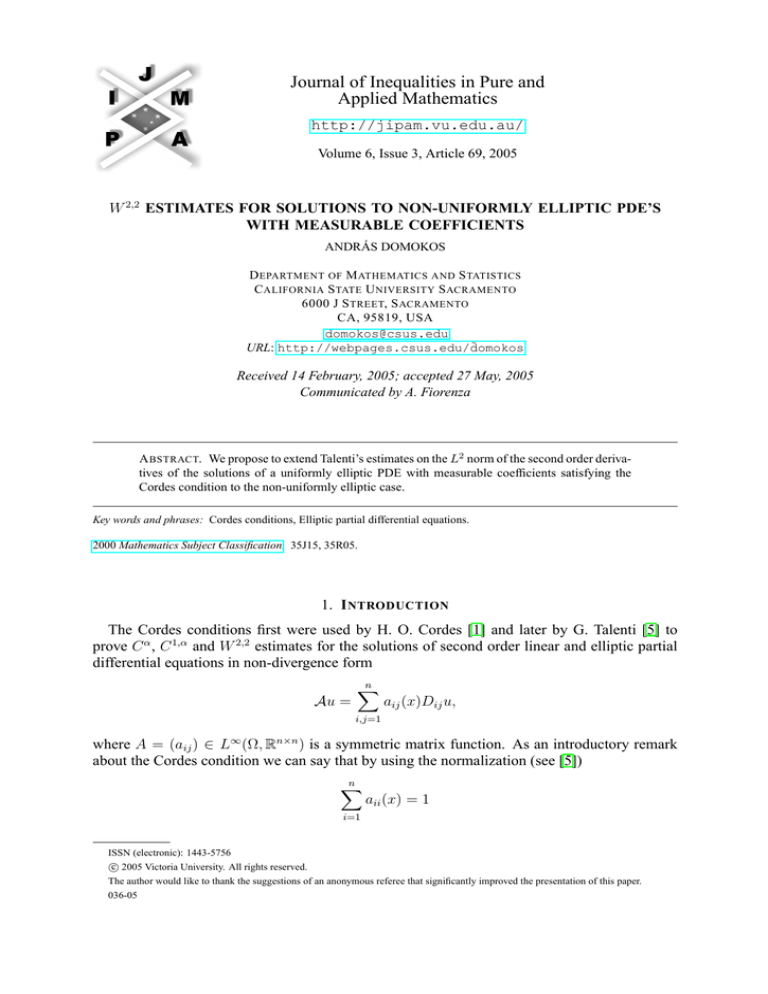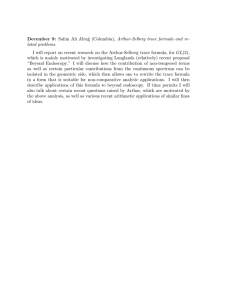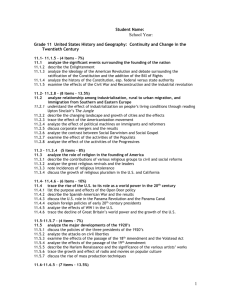
Journal of Inequalities in Pure and
Applied Mathematics
http://jipam.vu.edu.au/
Volume 6, Issue 3, Article 69, 2005
W 2,2 ESTIMATES FOR SOLUTIONS TO NON-UNIFORMLY ELLIPTIC PDE’S
WITH MEASURABLE COEFFICIENTS
ANDRÁS DOMOKOS
D EPARTMENT OF M ATHEMATICS AND S TATISTICS
C ALIFORNIA S TATE U NIVERSITY S ACRAMENTO
6000 J S TREET, S ACRAMENTO
CA, 95819, USA
domokos@csus.edu
URL: http://webpages.csus.edu/d̃omokos
Received 14 February, 2005; accepted 27 May, 2005
Communicated by A. Fiorenza
A BSTRACT. We propose to extend Talenti’s estimates on the L2 norm of the second order derivatives of the solutions of a uniformly elliptic PDE with measurable coefficients satisfying the
Cordes condition to the non-uniformly elliptic case.
Key words and phrases: Cordes conditions, Elliptic partial differential equations.
2000 Mathematics Subject Classification. 35J15, 35R05.
1. I NTRODUCTION
The Cordes conditions first were used by H. O. Cordes [1] and later by G. Talenti [5] to
prove C α , C 1,α and W 2,2 estimates for the solutions of second order linear and elliptic partial
differential equations in non-divergence form
Au =
n
X
aij (x)Dij u,
i,j=1
where A = (aij ) ∈ L∞ (Ω, Rn×n ) is a symmetric matrix function. As an introductory remark
about the Cordes condition we can say that by using the normalization (see [5])
n
X
aii (x) = 1
i=1
ISSN (electronic): 1443-5756
c 2005 Victoria University. All rights reserved.
The author would like to thank the suggestions of an anonymous referee that significantly improved the presentation of this paper.
036-05
2
A NDRÁS D OMOKOS
or strictly positive lower and upper bounds (see [1])
0<p≤
n
X
aii (x) ≤ P
i=1
we get a condition equivalent to the uniform ellipticity condition in R2 and stronger than it
in Rn , n ≥ 3. At the same time it seems to be the weakest condition which implies that A
is an isomorphism between the spaces W02,2 (Ω) and L2 (Ω) and implicitly gives existence and
uniqueness for boundary value problems with measurable coefficients [4]. As an application it
was used to prove the second order differentiability of p−harmonic functions [3].
If we assume that the Cordes condition is satisfied, then it is possible to give an optimal
upper bound of the L2 norm of the second order derivatives to the solution u ∈ W02,2 (Ω) of the
problem
Au = f, f ∈ L2 (Ω)
in terms of a constant times the L2 norm of f . An interesting method, that connects linear
algebra to PDE’s, has been developed in [5]. In this paper we will extend this method to not
necessarily uniformly elliptic problems and as an application we will also show a change in Talenti’s constant. More exactly, estimate (1.2) below holds in the case of operators with constant
coefficients, but needs a change to cover the general case.
Let us consider the bounded domain Ω ∈ Rn with a sufficiently regular boundary and the
Sobolev space
n
o
2,2
2
2
W (Ω) = u ∈ L (Ω) : Dij u ∈ L (Ω) , ∀ i, j ∈ {1, . . . , n}
endowed with the inner-product
Z
(u, v)W 2,2 =
u(x)v(x) +
Ω
n
X
!
Dij u(x) · Dij v(x) dx.
i,j=1
Let W02,2 (Ω) be the closure of C0∞ (Ω) in W 2,2 (Ω) and denote by D2 u the matrix of the second
order derivatives.
We state now Talenti’s result using our setting.
Theorem 1.1 ([5]). Let us suppose that for a fixed 0 < ε < 1 and almost every x ∈ Ω the
following conditions hold:
n
n 2
X
X
1
(1.1)
aii (x) = 1 and
aij (x) ≤
.
n
−
1
+
ε
i=1
i,j=1
Then, for all u ∈ W02,2 (Ω) we have
√
p
n − 1 + ε √
2
2
n − 1 + ε + (1 − ε)(n − 1) ||Au||L2 (Ω) .
(1.2)
||D u||L (Ω) ≤
ε
2. M AIN R ESULT
Consider the matrix valued mapping A : Ω → Mn (R), where A(x) = (aij (x)) with aij ∈
L (Ω), and let
∞
(2.1)
Au =
n
X
aij (x)Dij (u).
i,j=1
J. Inequal. Pure and Appl. Math., 6(3) Art. 69, 2005
http://jipam.vu.edu.au/
W 2,2 E STIMATES
3
p
We
use
the
notations
||a||
=
a21 + · · · + a2n for a = (a1 , . . . , an ) ∈ Rn andPtrace A =
Pn
matrix A = (aij ). Also, we denote by hA, Bi = ni,j=1 aij bij
i=1 aii for the trace of an n × nq
Pn
n×n
2
.
the inner product and by ||A|| =
i,j=1 aij the Euclidean norm in R
Definition 2.1 (Cordes condition Kε ). We say that A satisfies the Cordes condition Kε if there
exists ε ∈ (0, 1] such that
2
1
2
(2.2)
0 < ||A(x)|| ≤
trace A(x) ,
n−1+ε
for almost every x ∈ Ω and
1
∈ L2loc (Ω).
trace A
Remark 2.1. We observe that inequality (2.2) implies that for
√
n
σ(x) =
trace A(x)
we have
(2.3)
0<
2
1
1
2
≤
||A(x)||
≤
trace
A(x)
σ 2 (x)
n−1+ε
with σ(·) ∈ L2loc (Ω). Therefore without a strictly positive lower bound for trace A(x), the
Cordes condition Kε does not imply uniform ellipticity. As an example we can mention
p xy y
2
A(x, y) = p xy
x
2
defined on
n
o
y
Ω = (x, y) ∈ R2 : x > 0, y > 0, 0 < x2 + y 2 < 1, 1 < < 2 .
x
In this case inequality (2.2) looks like
x2 + xy + y 2 <
1
(x + y)2 .
1+ε
Considering the lines y = mx we see that
m
2
ε = inf
:1<m<2 =
2
m +m+1
7
and
√
σ(x) =
2
.
x+y
Remark 2.2. In the case when we want to have a strictly positive lower bound for trace A we
should use a Cordes condition Kε,γ that asks for the existence of a number γ > 0 such that
2
1
1
1
2
(2.4)
0< ≤ 2
≤ ||A(x)|| ≤
trace A(x)
γ
σ (x)
n−1+ε
for almost
P every x ∈ Ω. In this way the normalized condition (1.1) corresponds to the Kε,n ,
since ni=1 aii = 1 implies that γ = n.
We recall the following lemma from [5].
J. Inequal. Pure and Appl. Math., 6(3) Art. 69, 2005
http://jipam.vu.edu.au/
4
A NDRÁS D OMOKOS
Lemma 2.3. Let a = (a1 , . . . , an ) ∈ Rn . Suppose that
(a1 + · · · + an )2 > (n − 1)||a||2 .
(2.5)
If for α > 1 and β > 0 the condition
1
1
1
2
2
(2.6)
(a1 + · · · + an ) ≥ n − 1 +
||a|| +
n−1+
(α − 1),
α
β
α
holds, then we have
(2.7)
||k||2 + 2α
X
ki kj ≤ β(a1 k1 + · · · + an kn )2
i<j
for all k = (k1 , . . . , kn ) ∈ Rn .
The next lemma is the nonsymmetric version of the original one in Talenti’s paper [5]. By
nonsymmetric version we mean that we drop the assumption that A is symmetric. On the other
hand, it is easy to see that Lemma 2.4 below will not hold for arbitrary nonsymmetric matrices
P , even in the case when A is diagonal. For the completeness of our paper we include the proof,
which can be considered as a natural extension of the original one.
Lemma 2.4. Let A = (aij ) be an n × n real matrix. Suppose that
(trace A)2 > (n − 1)||A||2 .
(2.8)
If for α > 1 and β > 0 the condition
1
1
1
2
2
(2.9)
(trace A) ≥ n − 1 +
||A|| +
n−1+
(α − 1)
α
β
α
holds, then we have
(2.10)
n X
pii pij
||P || + α
pij pjj
2
i,j=1
≤ β hA, P i2
for all real and symmetric n × n matrices P = (pij ).
Proof. Consider an arbitrary but fixed real and symmetric matrix P . It follows that there exists
a real orthogonal matrix C and a diagonal matrix
k1
0
..
D=
.
0
kn
such that P = C −1 DC. Observe that
n 1 X pii pij
−
2 i,j=1 pij pjj
is the coefficient of λn−2 in the characteristic polynomial of P , therefore
n 1 X pii pij X
ki k j .
pij pjj =
2
i,j=1
i<j
Moreover,
(2.11)
n
X
i,j=1
J. Inequal. Pure and Appl. Math., 6(3) Art. 69, 2005
p2ij
2
= trace(P ) =
n
X
ki2 .
i=1
http://jipam.vu.edu.au/
W 2,2 E STIMATES
5
Hence, inequality (2.10) can be rewritten as
|k|2 + 2α
(2.12)
X
ki kj ≤ β
i<j
Let B = CAC
−1
n
X
!2
aij pij
.
i,j=1
. Then trace B = trace A and
hA, P i = trace(AP )
(2.13)
= trace(CAP C −1 )
= trace(CAC −1 CP C −1 )
= trace(BD)
n
X
=
bii ki .
i=1
Also, because B and A are unitary equivalent, we have
n
n
n
X
X
X
2
2
bii ≤
bij =
a2ij .
i=1
ij
i,j=1
Therefore, b = (b11 , . . . , bnn ), α and β satisfy the condition (2.6) from Lemma 2.3, and hence
n
X
X
k12 + 2α
ki kj ≤ β(b11 k1 + · · · + bnn kn )2 = βhA, P i2 .
i=1
i<j
Using (2.11) – (2.13) we get (2.10).
Theorem 2.5. Suppose that A satisfies the Cordes condition Kε . Then for all u ∈ C0∞ (Ω) we
have
p
1 √
n − 1 + ε + (1 − ε)(n − 1) ||σAu||L2 (Ω) .
(2.14)
||D2 u||L2 (Ω) ≤
ε
Proof. Fix x ∈ Ω such that (2.3) holds and consider an arbitrary α > 1/ε. Then
!2 n
X
1
aii (x) > n − 1 +
||A(x)||2 .
α
i=1
In order to choose β(x) > 0 such that
!2 n
X
1
1
1
2
(2.15)
aii (x) ≥ n − 1 +
||A(x)|| +
n−1+
(α − 1),
α
β(x)
α
i=1
observe that condition Kε is equivalent to
!2 n
X
1
1
2
aii (x) ≥ n − 1 +
||A(x)|| + ε −
||A(x)||2 .
α
α
i=1
Therefore we have to ask β(x) to satisfy
1
1
1
2
ε−
||A(x)|| ≥
n−1+
(α − 1),
α
β(x)
α
and hence
(n − 1)α2 + (2 − n)α − 1
(2.16)
β(x) ≥ σ 2 (x)
.
εα − 1
J. Inequal. Pure and Appl. Math., 6(3) Art. 69, 2005
http://jipam.vu.edu.au/
6
A NDRÁS D OMOKOS
Considering the function f : (1/ε, +∞) → R defined by
f (α) =
(n − 1)α2 + (2 − n)α − 1
,
εα − 1
we get that its minimum point is
α=
n−1+
p
(n − 1)(1 − ε)(n − 1 + ε)
.
(n − 1)ε
Therefore, the minimum value of σ 2 (x) f (α), which is coincidentally the best choice of β(x),
is
p
2ε − εn + 2n − 2 + (n − 1)(1 − ε)(n − 1 + ε)
2
β(x) = σ (x)
ε2
2
2
p
σ (x) √
=
n
−
1
+
ε
+
(1
−
ε)(n
−
1)
.
ε2
Applying Lemma 2.4 in the case of u ∈ C0∞ (Ω) and pij = Dij u(x), we get
Z X
Z
n
X Z Dii u(x) Dij u(x) 2
(2.17)
(Dij u(x)) dx + α
β(x)(Au(x))2 dx.
Dij u(x) Djj u(x) dx ≤
Ω i,j=1
i6=j
Ω
Ω
But, integrating by parts two times we get
Z
Z
(2.18)
Dii u(x)Djj u(x)dx =
Dij u(x)Dij u(x)dx,
Ω
Ω
and hence
(2.19)
Z Dii u(x) Dij (x)
Dij u(x) Djj u(x)
Ω
dx = 0.
Therefore, for all u ∈ C0∞ (Ω) we have
p
1 √
||D2 u||L2 (Ω) ≤
n − 1 + ε + (1 − ε)(n − 1) ||σAu||L2 (Ω) .
ε
Theorem 2.5 clearly implies the following result.
Corollary 2.6. Suppose that A satisfies Cordes condition Kε,γ . Then for all u ∈ W02,2 (Ω) we
have
√ p
γ √
2
(2.20)
||D u||L2 (Ω) ≤
n − 1 + ε + (1 − ε)(n − 1) ||Au||L2 (Ω) .
ε
Remark 2.7. In the case of trace A = 1 we get that
√ p
n √
2
(2.21)
||D u||L2 (Ω) ≤
n − 1 + ε + (1 − ε)(n − 1) ||Au||L2 (Ω) .
ε
If we compare estimate (1.2) with ours from (2.21) we realize that our constant on the right
hand side is larger. The interesting fact is that the two constants in (1.2) and (2.21) coincide in
the case when A = n1 I and ε = 1, and give (see [2])
||D2 u||L2 (Ω) ≤ ||∆u||L2 (Ω) , for all u ∈ W02,2 (Ω) .
Looking at Talenti’s paper [5] we realize that the way in which the constant B is chosen on page
303 leads to
1
(2.22)
||A(x)||2 ≥
.
n−1+ε
J. Inequal. Pure and Appl. Math., 6(3) Art. 69, 2005
http://jipam.vu.edu.au/
W 2,2 E STIMATES
7
Comparing this inequality to (1.1) which gives
1
1
≤ ||A(x)||2 ≤
n
n−1+ε
and therefore
1
||A(x)||2 =
,
n−1+ε
we conclude that (2.22) (and hence (1.2)) holds for constant matrices A but may fail for a
nonconstant A(x) on a subset of Ω with positive Lebesgue measure. Therefore, the estimate
(2.21) is the right one for nonconstant matrix functions A(x) satisfying (1.1).
Remark 2.8. Another interesting fact is found when applying our method to the case of convex
functions u. In this case we can further generalize the Cordes condition in the following way:
We say that A satisfies the condition Kε(x) if
1
∈ L2loc (Ω)
trace A
and there exists a measurable function ε : Ω → R such that 0 < ε(x) ≤ 1 for a.e. x ∈ Ω and
1
∈ L2 (Ω), and the following inequalities hold:
ε
2
2
trace A(x)
trace A(x)
1
(2.23)
0< 2
=
≤ ||A(x)||2 ≤
.
σ (x)
n
n − 1 + ε(x)
Inequality (2.17) in this case looks like
Z
Z X
n
XZ
Dii u(x) Dij u(x) 2
(Dij u(x)) dx +
α(x) β(x)(Au(x))2 dx .
dx ≤
D
u(x)
D
u(x)
ij
jj
Ω
Ω
Ω
i,j=1
i6=j
Observe that the convexity of u implies that D2 u(x) is positive definite, which makes the determinants
Dii u(x) Dij u(x) Dij u(x) Djj u(x) positive. We conclude in this way that under the Cordes condition Kε(x) for all convex functions
u ∈ W 2,2 (Ω) we still have
p
1 √
2
||D u||L2 (Ω) ≤ n − 1 + ε + (1 − ε)(n − 1) σAu
2 .
ε
L (Ω)
R EFERENCES
[1] H.O. CORDES, Zero order a priori estimates for solutions of elliptic differential equations, Proceedings of Symposia in Pure Mathematics, IV (1961), 157–166.
[2] D. GILBARG AND N.S. TRUDINGER, Elliptic Partial Differential Equations of Second Order,
Springer-Verlag, 1983.
[3] J.J. MANFREDI AND A. WEITSMAN, On the Fatou Theorem for p−Harmonic Functions, Comm.
Partial Differential Equations 13(6) (1988), 651–668
[4] C. PUCCI AND G. TALENTI, Elliptic (second-order) partial differential equations with measurable
coefficients and approximating integral equations, Adv. Math., 19 (1976), 48–105.
[5] G. TALENTI, Sopra una classe di equazioni ellitiche a coeficienti misurabili, Ann. Mat. Pura. Appl.,
69 (1965), 285–304.
J. Inequal. Pure and Appl. Math., 6(3) Art. 69, 2005
http://jipam.vu.edu.au/



![1. Let R = C[x].](http://s2.studylib.net/store/data/010491179_1-9a9c70e395518f466f652079f02ae14a-300x300.png)

